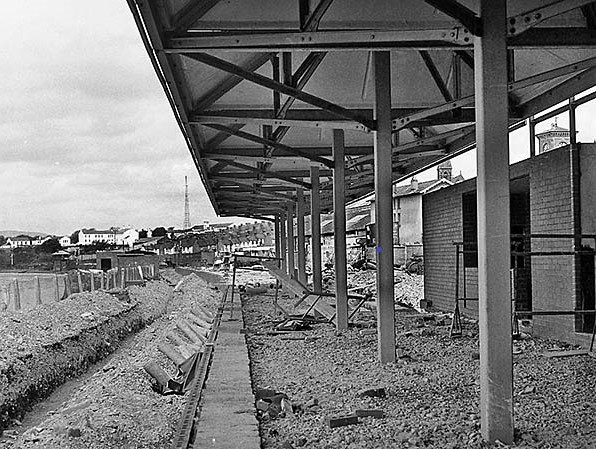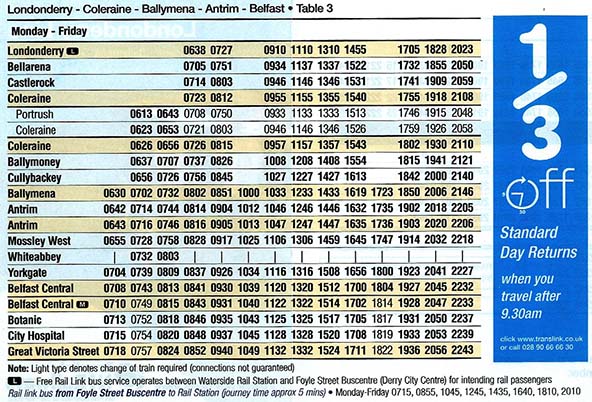|

Londonderry station under construction on 19 May 1979. In the distance adjacent to the River Foyle the Londonderry waterside signal box can be seen. It was replaced by a new signalling facility that would be housed in the brick building that can be seen in this view on the right. The new signal box opened with the station on Sunday 24 February 1980.
Copyright The Carlisle Kid and licensed under the Creative Commons Licence
On 18 July 1853 the 33 mile Londonderry & Coleraine Railway (L&CR) opened throughout (the section between Londonderry Waterside and Limavady having opened on 29 December 1852). The western terminus was at Waterside on the east bank of the River Foyle opposite the historic city of Derry/Londonderry, which is located on the west side of the river. From 19 November 1860, with the opening of the first Bann Bridge at Coleraine a direct connection had been made with Belfast. The L&CR was not the first railway to reach Londonderry and on the city side of the river was the Foyle Road station of Londonderry & Enniskillen Railway which had opened on 18 April 1850 (the line having reached the town on 19 April 1847).
From 1863 the L&C Waterside station was linked to the city by the steel Carlisle Bridge which replaced an old wooden bridge that was destroyed by an iceberg in 1862. The Carlisle Bridge would be replaced in 1933 by the double deck Craigavon Bridge.
After Londonderry Waterside had opened two further lines reached Derry/Londonderry and by 1900 there were four terminus stations servicing the city (the other three being Foyle Road, Graving Dock and Victoria Road).
 The L&CR had been taken over by the Belfast & Northern Counties Railway (BNCR) who rebuilt Londonderry Waterside station in 1874. In 1903 the BNCR was taken over by the Midland Railway Northern Counties Committee, which was in turn absorbed into the London Midland & Scottish Railway on 1 January 1923, by which date the island of Ireland had been divided into two separate countries, the Irish Free State and Northern Ireland, Londonderry being located in the latter. In April 1949 the railways within Northern Ireland were nationalised under the Ulster Transport Authority (UTA). The L&CR had been taken over by the Belfast & Northern Counties Railway (BNCR) who rebuilt Londonderry Waterside station in 1874. In 1903 the BNCR was taken over by the Midland Railway Northern Counties Committee, which was in turn absorbed into the London Midland & Scottish Railway on 1 January 1923, by which date the island of Ireland had been divided into two separate countries, the Irish Free State and Northern Ireland, Londonderry being located in the latter. In April 1949 the railways within Northern Ireland were nationalised under the Ulster Transport Authority (UTA).
The UTA was notoriously anti-rail and began a programme of line closures which affected the whole country leaving only a very small network of railways. During the UTA era Londonderry witnessed the closure of three of its terminus stations, Londonderry Graving Dock (opened 31 December 1863 and closed 6 September 1948), Londonderry Victoria Road (opened 6 August 1900 and closed 23 September 1955) and Londonderry Foyle Road (Opened 18 April 1850 and closed 15 February 1965). This left Derry/Londonderry with only the line to Coleraine (and onwards from there to Belfast) and only the one station at Waterside.
During the 1970s Londonderry Waterside was bombed by the IRA on two occasions. The second bombing, which occurred on 4 May 1978, was particularly devastating. Four bombs were exploded in the station causing extensive damage to the building and to rolling stock that had been stabled there. NIR was able to secure compensation through a criminal damage claim. Rather than use that money to repair the old station a decision was taken to build a new one.
Land to the west of the Waterside station that had once been occupied by sidings was identified as a suitable location for a new more basic station and work commenced in 1979.
The new Londonderry station opened to passengers on Sunday 24 February 1980. It consisted of a single storey building that fronted onto a traffic circulating area that connected to Duke Street. The new building was an entirely charmless and an unworthy successor to the old Waterside station. At the rear of the building was a single island platform with two faces. The west facing side of the platform was the longest and it was numbered as platform 1. The east facing side was numbered as platform 2.
 The station building also contained a signal box which controlled the platform lines and some sidings. There were five sidings in all, three of which were within the old Waterside station. Two of the sidings were adjacent to the old station and they were referred to as ‘Goods Sidings’. On the Castlerock side (north) of the yard there were two ‘temporary freight sidings’. Entrance to both areas of sidings was controlled from the signal box. Through freight services to the Republic of Ireland from Londonderry were still running when the new station opened and sidings were used by them. The station building also contained a signal box which controlled the platform lines and some sidings. There were five sidings in all, three of which were within the old Waterside station. Two of the sidings were adjacent to the old station and they were referred to as ‘Goods Sidings’. On the Castlerock side (north) of the yard there were two ‘temporary freight sidings’. Entrance to both areas of sidings was controlled from the signal box. Through freight services to the Republic of Ireland from Londonderry were still running when the new station opened and sidings were used by them.
The first departure from the new station was a Belfast Central train which left at 17.40 (the last departure from the old station, also for Belfast Central, left at 11.30). From November 1860 until 22 January 1978 Belfast York Road had been the terminus that Londonderry trains had used in that city. The route they had taken south of Antrim was via Templepatrick and Bleach Green Junction. On 12 April 1976 Belfast Central station had opened and it was decided that Londonderry trains would use that station. To do so they had to use a different route south of Antrim. A route that had once been part of the Great Northern Railway Ireland between Antrim and Knockmore Junction (west of Lisburn) had to be followed and from 23 January 1978 that was the route that Londonderry – Belfast services took.
On 9 August 1980 special trains were operated for the annual Apprentice Boys March which takes place in Derry/Londonderry. As there were only two platforms at Londonderry station the eastern platform at the closed Londonderry Waterside was also used. This practice continued on the closest Saturday to 12 August each year, until 10 August 1985.
The NIR timetable published 16 June 1980 showed that from 1 September that year Monday-to-Friday there were six departures all of which went to Belfast Central. On Saturdays there were also six trains to Belfast Central but there was also an evening service (departed 20.25) for Coleraine which offered a connection to Portrush. On Sundays there were just two trains to Belfast Central.
The regular freight services that ran to the Republic of Ireland had ceased by June 1983 but some sidings were retained for use by the engineering department and for stabling passenger stock. Sporadic freight flows, consignments of fertiliser, continued to be handled at Londonderry.
By the end of 1985 the sidings that ran into the old Waterside station had been cut back to a point outside the trainshed.
On 26 May 1990 the Branch Line Society ‘Ulster Enterprise I’ rail tour visited Londonderry. It went into what was at that time the only surviving platform of the old Waterside station before shunting into the 1980 station.
The fertiliser freight traffic had ceased by the end of 1996.
Developments at Belfast in 1976 had impacted on Londonderry services and they would do so again. On 28 November 1994 the Cross Harbour line opened at Belfast. This line linked the Belfast York Road – Larne line to Belfast Central by a new section of railway that crossed Belfast Harbour. On 15 October 2001 NIR reopened the 15 mile Antrim – Bleach Green Junction line (which had been closed to passenger services in 1980) and from that date services from Londonderry ran via that line to Belfast Great Victoria Street (via York Road).
The NIR timetable published on 13 December 2009 showed nine departures and nine arrivals Monday-to-Friday. On Saturdays there were eight trains in each direction and on Sundays five. The 2009 timetable below shows the weekday departures from Londonderry.

During the period Sunday 29 July 2012 and Sunday 24 March 2013 Londonderry station was closed for passenger rail services with buses replacing trains. This was to facilitate an upgrading of the route between Londonderry and Coleraine which included new track and new signalling.
In 2010 the idea of creating a new station for Derry/Londonderry was mooted and as the original Waterside station was still standing, and listed, consideration was given to using it to create a modern transport hub. In 2016 NIR confirmed that it was going to create a new facility within the Waterside station.
In September 2018 platform 2 was taken out of use and its track was lifted so that works associated with recommissioning the Waterside station could go ahead. On 8 October 2019 the station was closed completely so that the remaining works could take place. The new facility, called Derry/Londonderry, at the old Waterside station, opened for rail traffic on 21 October 2019. The 1980 Londonderry station was demolished over the two days of 5 and 6 December 2019. The site was then developed as a car park.
With special thanks to Jim McBride and Edwin McMillan |

 Home
Page
Home
Page

 Home
Page
Home
Page